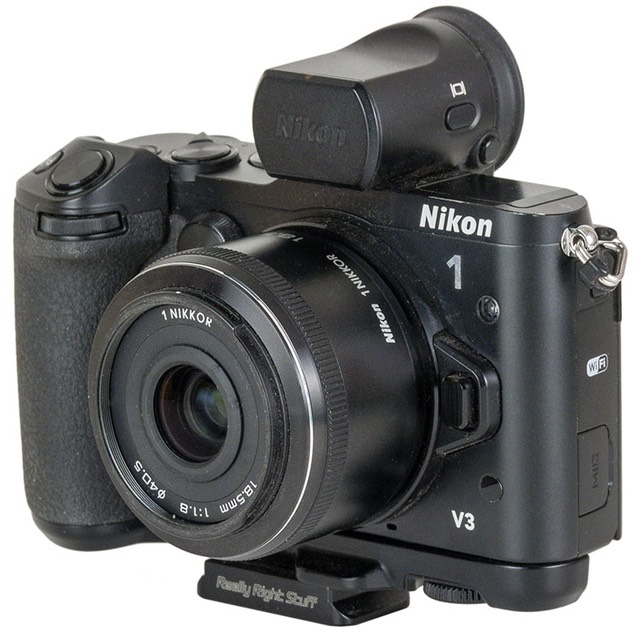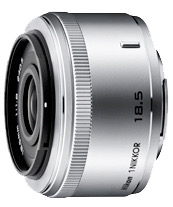
What is It?
The 18.5mm f/1.8 for the Nikon 1 cameras (CX mount) is the “normal speed” lens for the system. That’s because after the 2.7x crop adjustment, it’s equivalent to a 50mm lens. At f/1.8 it’s also about as fast a lens as Nikon makes for the system (the 32mm f/1.2 being the only other fast lens).
While it looks like this lens has a focus ring, it doesn’t. It has no user controls at all. About the only thing you can do externally is to add the optional HB-N104 lens hood, which bayonets on the front of the lens but is a bit different than the usual tunnel of plastic (or metal) you usually get with a hood. It’s more of a enclosure than a tunnel, with the whole thing slanting in slightly to reveal an even narrower opening in its “roof.” The net result of the lens hood is that it is small but effective. In some ways it is similar to hoods Voigtlander has done with some of their small prime lenses.
Overall, the lens is quite small (only 36mm long) and light (70g). The front filter size is 40.5mm and doesn’t rotate during focus. Nor does the lens extend during focus.
Inside, there are 8 elements in 6 groups, with one being aspherical, so a rather simple lens design, as you’d expect for a normal lens. There are seven rounded aperture blades, but the aperture itself is step less, which is useful for video work.
A close focus distance of 8.4" (0.2m) doesn’t give you a lot of “macro-ness” to the lens; maximum magnification is a measly 1:8.3.
The lens is available in black, white, or silver.
How’s it Handle?
The front cap that comes with the lens also fits the hood, so I tend to just leave the hood in place on this small lens. What else is there to comment about on a lens that doesn’t have any controls?
As you’d expect, a normal prime mounted on any Nikon 1 body makes for a reasonably compact and light package.

How’s it Perform?
Exposure: Yep, I’m writing about exposure again, because it’s an important nuance on Nikon 1 bodies. From an exposure standpoint, f/1.8 is f/1.8. So, yes, this is a fast lens designed for low light.
But you have to remember that from a light gathering standpoint (how many photons get recorded), the 1” sensor is 2.7x worse than full frame. So we actually have a “system” that’s closer to an FX f/5 one when used in really low light. That’s not terrible, but don’t think you’re going to solve the Nikon 1 small sensor problem with just an f/1.8 lens. As the light goes down this lens is not going to suddenly turn the V3 or other Nikon 1 into a low-light master. The photosite size is just too small, and the random nature of photons is going to definitely produce noise (quantum shot noise).
On the other hand, this lens is more than a stop faster than the 10mm or any of the kit zooms. That means that instead of pushing out to an iffy ISO 1600 in lowish light you might be able to keep to a much more usable ISO 640-800.
In essence, this lens is doing the same thing for a Nikon 1 as a fast normal prime does for the other bigger systems (e.g. DX and FX). It’s just doing it for a smaller, less efficient sensor.
Sharpness: Overall quite good for a small, inexpensive lens. Optimal performance and excellent edge-to-edge performance is reached at f/2.8, but it’s quite sharp in the center wide open. I really wouldn’t be afraid to shoot this lens wide open, though the extreme corners will be a little softer (and darker, see below). While this wasn’t the top performing lens optically on my V3, it’s a close second.
Linear Distortion: A surprising amount for a “normal” lens: about 2% (barrel type). The good news is that it is a very straightforward barreling, and not a more complex type of distortion as we sometimes find these days with lenses that have aspherical elements, so easily removed. Still, when you remove 2% distortion you lose some pixels, and some of the Nikon 1 models (e.g. first generation) are already low in count to start with.
Vignetting: Again, a surprising amount with there being more than a stop and a half wide open, and still about two-thirds of a stop at f/2.8. Then again, if you’re shooting JPEGs, turning on the in-camera vignetting control will remove about half that, which puts us in the reasonable realm. Basically, if you don’t like vignetting, you’ll need to get down to f/4 to keep it down to mostly imperceptible levels.
Chromatic Aberration: Yes, there’s at least a pixel’s worth of CA at all apertures, slightly worse in the middle apertures. This is another thing that is corrected in JPEG shooting, though. The lens also has some longitudinal chromatic aberration, but not enough to get worried about most of the time (see next). It’s mostly gone by f/5.6, but frankly, it’s not as bad as some of the FX primes wide open.
Bokeh: I’m not impressed by the bokeh of the lens. The aperture blades in my sample don’t make for a perfect round on out of highlights, and it tends to produce a considerable amount of longitudinal aberration, as well, even stopped down.
Overall: For the most part, exactly what you’d expect from a low cost, fast, normal prime with one exception: not much loss of contrast wide open.
Final Words
Given the price, if you have a Nikon 1 system and you’re pained at all by higher ISO noise, it’s worth picking up this lens for the same reason you’d pick up the 35mm f/1.8 DX for the consumer DSLRs: it’s sharp, even wide open, and its weaknesses are fairly benign for most shooting. Just remember, you’re using a small sensor camera and that random photon noise isn’t really “fixed” by using a fast lens, so in low light you’ll still get some noise (mostly luminance). If you’re looking for dreamy, soft backgrounds, you also won’t quite get that due to the bokeh on this lens. Those out of focus areas will still look better than you’ll get out of the zooms, though.
The strange thing is that this lens is probably the one piece of Nikon 1 kit that really delivers most on the promise of Nikon 1: small, light, highly competent, doesn’t get the in way, and affordable. A lot of the other Nikon 1 gear can’t make all those claims, and some can’t make more than one or two of them.
I got the distinct impression with the 18.5mm on the V2/J3/J4 that “this is the way the Nikon 1 system should have been from day one.” Nikon needs to produce a 28/35mm equivalent prime that’s f/1.8, small, competent, and affordable, as well.
Support this site by purchasing from this advertiser:
